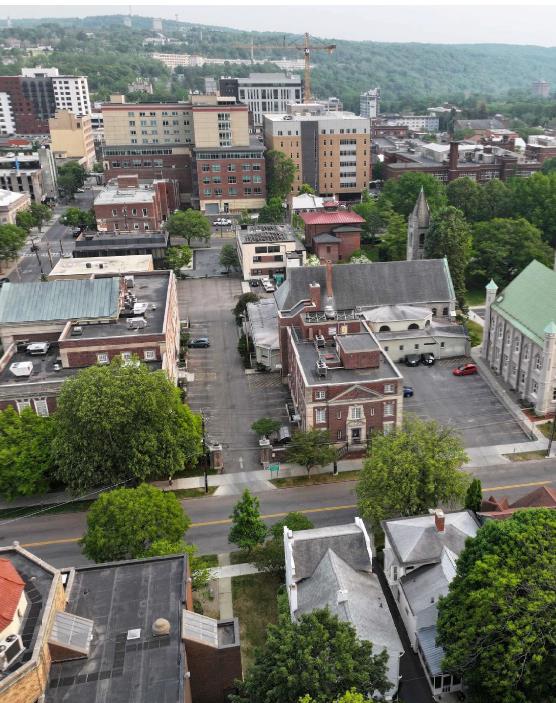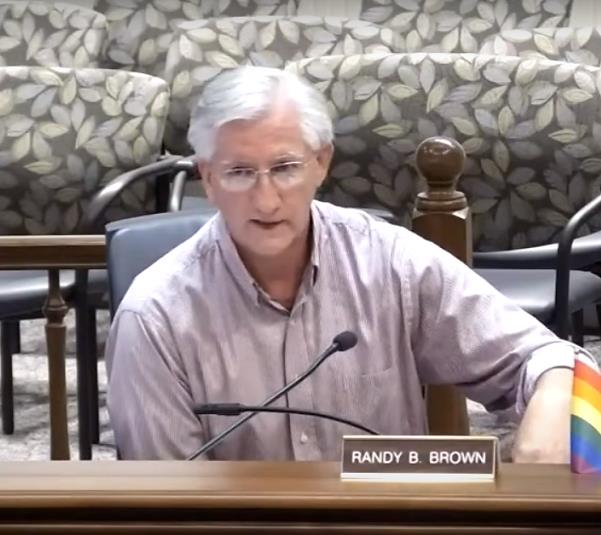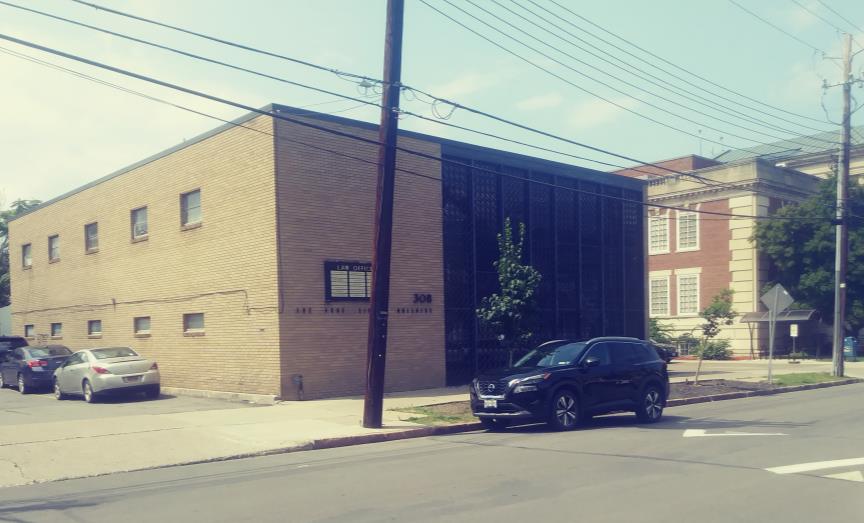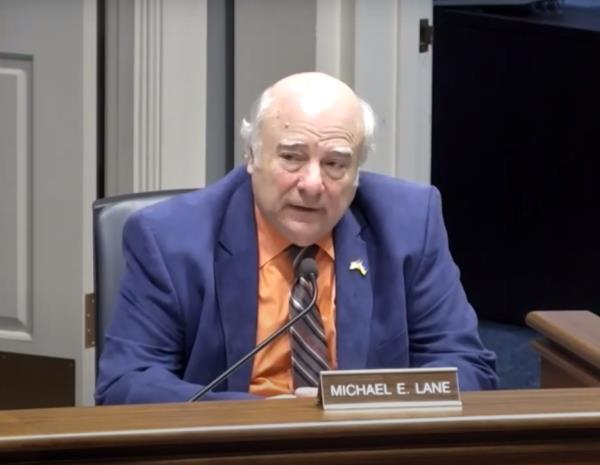Brown’s Committee would pre-empt Ithaca’s review of downtown demo
by Robert Lynch; January 9, 2024
(Update; January 17, 2024): By unanimous vote of the 13 members present, the Tompkins County Legislature January 16th endorsed the recommendation one week earlier of the Downtown Facilities Special Committee and agreed to apply the “Monroe Balancing Test” to its dealings with the City of Ithaca over deconstruction of the buildings on the site of the County’s proposed Center of Government.
“Basically it’s saying that the buildings at 300 and 308 North Tioga Street are no longer needed for the current use that they have, and that we can move forward to deconstruct them,” Downtown Facilities Committee Chair Randy Brown, explained to the Legislature, Brown minimizing the proposed Resolution’s legal impact. No legislator chose to discuss the Resolution. The measure was adopted by a roll-call vote within seconds.
The previously-filed story, based on the January 9th committee deliberations, follows:
****
A key committee of the Tompkins County Legislature, chaired by Newfield-Enfield’s Randy Brown, Tuesday made clear that it wants the two buildings bought on the site of a new downtown Center of Government removed sooner rather than later. And the committee would employ an obscure Rochester-based lawsuit to muscle past any City of Ithaca resistance to the County’s doing so.

By a unanimous seven-member vote, Brown’s Downtown Facilities Special Committee recommended Tuesday that Tompkins County accept the so-called “Monroe Balancing Test” in an attempt to circumvent Ithaca City rules that might otherwise require it to share specific plans for the proposed five-story office building before City Hall allows the County to deconstruct the former Key Bank Building on the corner of Buffalo and Tioga Streets, as well as the one-time Wiggins’ Law Office structure next to it.
“I’m happy to have any discussions with the City, but I’m opposed to us filling out an application for a building permit,”, committee member Mike Lane of Dryden, arguably demolition’s strongest advocate, said emphatically. “We’re a county, and if we don’t hold our authority here, we’ll lose it,” he said.
“My understanding is that the City tends to oppose deconstruction unless there’s a plan going forward,” legislator Deborah Dawson posed to the committee. “So what happens now that we’ve done our balancing test?” she asked. “Can we deconstruct the buildings, or are we still on hold?”
No one that morning gave Dawson a clear answer. The best County Administrator Lisa Holmes could offer is that what the committee had just done—and what, one presumes, the full Legislature must still ratify—was to approve a test that “identifies the steps” in moving ahead toward demolition and in dealing with City Hall.
Committee members later in the meeting informally requested administrators draft another Resolution in time for their next meeting. It would call for deconstructing both the Key Bank and Wiggins’ buildings in 2024, a full year ahead of what Holmes had previously given the committee in a Center of Government construction timeline.
“We’re committed,” Brown remarked, signaling his move forward toward a Center of Government. “The Legislature, I think, voted to build this, didn’t we?”
Someone in the room affirmed the chairman’s assessment. But a close reading of the record suggests that any prior vote to proceed was nothing more than a statement of intent. It was nothing that lawmakers couldn’t later walk back .

“So that, to me is the real test,” Brown concluded based on the quasi-commitment. “We’re moving forward,” he continued. “So that to me is giving us permission to knock these buildings down.”
Tompkins County, following two years of secret negotiations, purchased the Key Bank and Wiggins buildings in 2021 for a combined nearly $3 Million. All the while, they’ve seen the lot as the site for a long-sought Center of Government. At the time of the announced purchase, one legislator termed it “a once in a lifetime opportunity.”
Current plans call for constructing a new, five-story office building that would consolidate Tompkins County departments in one structure adjacent to the Courthouse. Estimates place the Center of Government’s construction cost at $40 Million and rising. Holmes’ timeline would have the building finished by 2028, after which a third structure, the County Assessment and Elections offices—so-called “Building C”—would also be razed.
“The buildings are just deteriorating,” Dawson remarked about the two purchased structures, now largely vacant. “They’re just an attractive nuisance.”
But Ithaca City officials may view the matter differently. The “Monroe Balancing Test” that County officials intend to employ seeks to push past a chapter in the Ithaca City Code that would subject design review of any new government building to oversight by the Ithaca Landmarks Preservation Commission. The Commission would have input because the Courthouse lot stands adjacent to DeWitt Park and within the DeWitt Park Historic District.
“Subjecting the project to review by the Ithaca Landmarks Preservation Commission and the Certificate of Appropriateness process may subject the project to revisions and/or conditions that will not be compatible with the goals and objectives of the County in developing the Center of Government and will add significant cost to the desired Center of Government project,” a detailed, more than 2000-word narrative that County Government relies on as it’s “balancing test” states.
The narrative was likely written by an (unnamed) outside attorney the County Legislature commissioned to conduct its legal analysis.
Should the full Legislature continue to press forth with its arguably bull-headed approach toward overriding City Hall concerns, the action could set the stage for a nasty lawsuit; that is, should City Hall choose to press it. In recent months, the full County Legislature has conducted numerous closed-door executive sessions at the close of its public meetings. The threat of legal action by the City may have been a prime subject discussed.

“The County’s legislative grant of authority is well documented and broad,” the lawyer-prepared “balancing test” document states. A careful reading of what the attorney wrote, however, finds very little “balancing.” Rather, it advocates a one-sided, County Government point of view. It provides City of Ithaca preservationist interests short shrift.
Based on committee discussions Tuesday, a prime rationale for asserting County Government’s pre-emptive power is that of timing. Legislators want to demolish the existing structures as soon as they can. But architects have yet to design any sketch for the Center of Government. In fact, the architects have yet to be named. And just one month ago, legislators were still debating whether to make the building five stories tall, or only four.
For those buried in law books, the “Monroe Balancing Test” bases its analysis on a 1988 New York Court of Appeals Decision, City of Rochester v. County of Monroe. In its holding, New York’s Highest Court granted Monroe County immunity from the design review requirements that the City of Rochester had attempted to impose over improvements including a terminal expansion and parking garage construction at Monroe County’s large international airport.
But a legal adversary in this instance could fault “Monroe County” for being only minimally on-point. The Court’s holding in Monroe County focused heavily on rights accorded government’s “proprietary functions” as opposed to its other activities, and also on the importance of airports in contemporary society.
An expansive, immovable, large-city airport, one could argue, deserves greater legal deference than does a newly-conceived office building more easily placed elsewhere. In fact, several Tompkins County legislators, openly or privately, have suggested that consolidated government offices could better be placed within unused parts of the Shops at Ithaca Mall.

Moreover, Rochester v. Monroe County fails to address any historic preservationist argument, the kind the City of Ithaca is likely to raise.
“Overall, the preferred location on the 300 block of N. Tioga Street maximizes efficiency by maintaining County Departments and Offices in the downtown central governmental core of the City of Ithaca and provides numerous other public benefits,” the Tompkins County Balancing Test narrative asserts.
“The impact upon the legitimate local interest of the City of Ithaca is positive,” the document continues, arguing, “[T]he City of Ithaca is the largest population center in Tompkins County, and by building and locating the proposed Center of Government in the heart of the City the County will be able to equitably deliver services to said population.”
“This same benefit would not be achieved if the County were to construct the Center of Government in another part of the County,” the position paper claims.
****
The Downtown Facilities Special Committee did not belabor the legal question before it Tuesday. After a 35-minute closed discussion over matters not disclosed in specifics, members cast their unanimous vote for adopting the balancing test, taking only a quarter-hour’s time to discuss it. They took much longer, in fact, discussing exactly when and how the two mothballed buildings would be torn down.
When chair Randy Brown asked whether all wanted them both down this year, Mike Lane chimed in, “Absolutely!”
Expect a Resolution ASAP.
###

